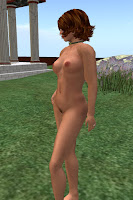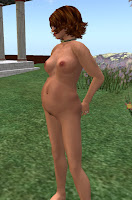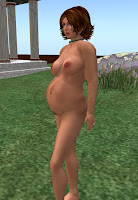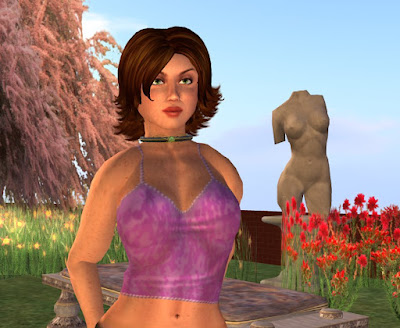The Art of making a shape
There is an Art to making a shape. A sort of undefinable something that's really hard to describe. And its true that some people have this 'something' and some simply do not. But its not a binary thing at all, there are degrees of Arty-ness in all of us. Some of it is a matter of skills and knowledge. I hope to show you how to improve both of those in this post. But some of it is also a matter of having an 'eye' for beauty and what is 'right'. There will be people who have the skills and knowledge and have this 'eye' too and they will be able to produce avatars of exceptional beauty. Hopefully, some of these people have opened stores and are selling their wares... but that doesn't remove our interest in doing our own thing. You may or may not see yourself as arty... set that aside for a while and give it a try. I think most people have more arty-ness in them than they think.
The point of this post is not so much for you to make shapes that you can sell.... But for you to be able to make your shape feel right to you... to be right for you. And for your shape to be unique....just for you.
I'm not sure where I fall in the spectrum of arty-ness... I think I do have some degree of the 'eye' for beauty, but I am regularly impressed by some Avatars I see and simply go, 'Wow, how did they do that?!" And then I have the fun of trying to figure it out.
Height
The first question that pops up in making your own avatar is the question of height. My avatar is a realistic height though a bit on the short side at 5' 1". And often in a group of random people in SL, I'm a shrimp. I'd really like to know what the average height of avatars in SL are but I don't know of any such statistics. I think most women are well over 6 feet tall, and most men are well over 7 feet tall... I couldn't prove it though. I'm speaking of the non-furry community here. Furries, to their credit, do not seem to suffer from the need for greater height.
Some of the height confusion has to be laid at LL's doorstep. Their otherwise fine AV Shape editor seems to give an incorrect estimate of height in all situations. I'm 5-1 and yet the AV shape editor reports me as being 5.76 feet, which works out to about 5-9. There is a simple command in LSL (Linden Script Language) that returns the height of the Avatar (with shoes, oddly enough) so its not like its a mystery or difficult. Maybe in a future post I'll show you how to create a thingie to measure your avatar's height... its really not hard at all.
For now... let's set the question of height aside and focus on proportions. How long should legs be, in proportion to the rest of your body? How long should your arms be? How large should your hands be? And for women, how to get your breasts to look realistic? And....
How do you know how you look? Well you have to look at yourself, of course. Second Life provides a nice way of doing this and I have found that many people who have problems with their shape are ignorant of this feature... So we'll make sure you can all see yourself by talking about that first.
Camming
Camming is a strange word... it means to manipulate your view of the world in second life to something that is not the normal 'above and behind' view that you see as you walk around. The reason its called 'camming' is that it refers to an invisible and not so imaginary camera that your viewer uses to see what is going on in Second Life. As you walk around, that camera is above and behind your head looking slightly down. So.... that's why you see what you see. When you 'cam' you are moving that camera around. You can move it to look more closely at distant things, or use it to look at yourself from all angles.
Here's how you do it....
- Place your right hand on your mouse and your left had over the alt and control keys on the left side of the keyboard.
- Press and HOLD DOWN the alt key and click your left mouse button down AND HOLD IT DOWN.
- Now move your mouse. Right and left... Forward and backward. Notice how your 'view' moves. That is your camera moving... you are camming.
- Now continue to hold down the alt key and the left mouse button, and use another finger on your left hand to ALSO press and HOLD DOWN the control key.
- Move your mouse some more... Right and left, forward and backward. Notice that the forward and backward motion is now different than it was before.
- (To get back to the normal above and behind view, press escape. )
What if you don't have a mouse? How about those with a laptop?
Well, I'm sorry to say this, but you really should get a mouse. Get a nice small wireless mouse and use it for this if you use it for nothing else. They're not expensive. I use a laptop myself and have done so for many years, and I think a mouse is really needed for a good Second Life experience. If you have one of the Lenovo Thinkpads (was IBM) you do have a good alternative to a mouse in that little red nubby thing in the middle of the keyboard. But for everyone else, you'll need a mouse.
What about the Mac users? Control? Alt? What's that? After a bit of Googling I found this: In short, the Control key is the Mac's Command key. And the Alt key is the Mac's Option key.
Proportions
I'll avoid the whole, what is beautiful and what is handsome question like the plague. *grins* Instead we'll talk about proportions. What is 'normal' for the human body. Of course, you may fairly question the idea of 'normal' but if you google human proportions you'll find a broad literature talking about it. As you look through these links, you'll find that the 'head length' seems to be the standard measure and you'll quickly find that we are all supposed to be 8 head-length's tall. We're not of course. Here's a good video that will give you an introduction to the whole idea of proportions and also inject some reality into the whole 8-head-length idea.
Also look at this site...I think the images are particularly nice. Note that the male figures also say that the normal is about 7 1/2 heads tall.
Human proportion images
The thing is... *coughs* .... who wants to be just.... well.... normal?
No one of course. *grins* We want to be models, or heros, or Orcs, or Gnomes, or something else. But certainly not normal. This is SECOND Life after all. But even with that, normal is a good place to start. And making our legs a little longer, our breasts a little bigger and perhaps a little less sagging is all part of the game. And for men, having that broad chest with massive pects and biceps, and all without steroids! Well, its a good thing.
Personally, I think the guy in the video tape makes a good case for a 7 1/2 heads starting point with legs 4 heads long and arms 3 heads long. Then if you want to go for a modeling/fashion look... then lengthen your legs and body slightly.
Common Proportioning Errors
As I wander through second life I do see some errors people have made in their shapes. Usually a person will jave just one of these errors, rarely do I see someone with two and I don't think I've ever seen someone with three. But I thought I'd list them so you can increase the power of your observations.
And... who knows... you might see one of these in your own shape. If you do, and want to make a change to your shape, be sure to do it on a COPY of your shape. I've done this so often to my shape that I've taken to adding a date to the modification I make, and a height I'm trying for too. So I have shapes named things like "Robin's 5-1 110205" where that number is a YYMMDD format.
- Too long legs! We all want longish legs, that's what high-heels are all about. But there can be such a thing as too long. When you start looking like you might be on stilts, that's the time to wonder. If you're a woman remember to look at yourself in heels. That adds another 4 to 6 inches and may just put you over the top.
- Too short arms! If you use the Second Life avatar shape editor and just increase your height, there's a good chance that you'll end up with arms that are too short. They should be about 3 heads long.
- Push-up bra breasts.... with no bra! This is a common problem with home made avatars, and quite a few store-bought avatar shapes as well. If your breasts look like someone pasted half of cantaloupes to your chest, then this is your problem. Breasts do not have the same shape at the top as they do at the bottom... There's this thing called gravity! If you want the push-up bra look when you're dressed, that's certainly an ok thing -- but then be sure to make another version of your shape for when you're undressed or in a bathing suit. You'll be much happier with the result.
- Too small a head! I see this quite often on guys. They have increased their height, chest size and muscles but have done nothing for their head. So... guys... you don't want to look like a pin-head do you? Make it a bit bigger... and your neck a bit thicker too. Try for at least a size that would make your height 9 heads total. Eight would be better. That doesn't mean I'm suggesting you reduce your height... just increase the size of your head.
- Scrunched bottom! I see a lot of people, both men and women who's bottoms that are scrunched vertically. Its quite strange looking in naturalist or nudist Sim. I suppose its no big deal if you never get naked though. The fix is in the torso->hip length control make your hips Longer.
- Too long a trunk! I think what some women have done is to take their basic shape and make it a bit shorter. But the SL shape editor does not reduce height proportionately across the entire body.... I think it focuses mostly on the legs. So this might also be titled 'too short legs' but if shorter is what you're trying for, then your legs may be ok - its your trunk shoulders to crotch that is too long.To fix this use the controls to control the Hip and Torso length. Also watch the Neck length too.
- Pasted on smile! I know, I know, this person is trying to communicate that he or she is a friendly and happy person. But using the up-turned corners on the mouth control in the SL avatar editor to make this happen just looks scary. Instead get one of those things that make you smile every now and then. Come to think of it... that's something I can easily show you how to make in a future post.
- Surprised eyes! Its easy to make your eyes too open, too round. I've done it myself. When you do so it makes you look like you're surprised all of the time.
- Jaw-line too high, too sharp! I think this is simply a flaw in the editor, it lets you make your jawline much too upward sloping. It might be a good thing if you're trying to make an avatar of the Wicked Witch of the West (along with the required green skin). But for most of us its way too much.
First for the guys... if you're going for a buff look, I think I'd skip avatar physics completely. Being buff, and having things jiggling is just not right, and could be downright disturbing. If, however, you're making an overweight avatar, by all means, go for it. You can get a jiggling belly, butt and man-boobs very easily.
Now for us ladies... My advice would be to copy your walk animation from your AO and then run it in-world so you can see the effect of the changes you make. Use the Camming we talked about above to look at yourself from the front as you use the animation to walk in place. Walking is the most common thing, but turning, jumping and running are important too - so if you can do those as well, by all means do so.
Assuming you're going for a trim figure, you will want to minimize the belly bounce, perhaps you will want just a little butt bounce and your boobie bounce and sway will depend on how your breasts are shaped. Larger and more pendulous, more bounce and sway... smaller, less bounce and sway.
If you're making a pregnant shape, play attention to the advanced parameters too. Adding some Mass and Gravity to your belly will move it down a little into a more natural position. And some mass and gravity on our breasts can make them sag and sway more realistically.
Avatar physics errors....
- Everything is moving! The most comon problem I see is for everything to be moving all over the place. If you're a heavy woman, then that's appropriate when you're walking around naked... but not so much when you're clothed. You may want to make two avatar physics layers one for each condition.
- Prim thingies don't move with my avatar physics! If you have a dress with a prim lace trim along the top passing over your breasts. And you have turned your avatar physics on, you will find that your prim lace will be stationary as your breasts bounce and sway though the lace. Its even worse if you have bought prim nipples. I'll leave it to your imagination. The solution? Don't wear the prim... or don't wear the avatar physics layer. Its as simple as that.
I've probably scared you off now. So many ways to go wrong!
It's not really that bad though. You're probably fairly happy with the shape you have but just want to make a little change. Perhaps your lips need to be a little more full... or you need more lower lip .... or your nose is too narrow... or you breasts are too small. All of those things are easy and simple to adjust. Just remember to make your adjustments to a copy of your current shape so you have a way to back up without having to remember each and every tweak you made.
I'll use myself as an example for you. At times, I like to play using the Mama Allpa hud. It gives me a realistic menstrual cycle and a few other things too... like the possibility of pregnancy.
 So... if that happens, I need to adjust my shape as I proceed through my pregnancy... What I do is make up three more shapes based on my normal shape. First here's my normal shape to the right. (as always click on the picture to see a larger version - and you may be able to click again to see an even larger version).
So... if that happens, I need to adjust my shape as I proceed through my pregnancy... What I do is make up three more shapes based on my normal shape. First here's my normal shape to the right. (as always click on the picture to see a larger version - and you may be able to click again to see an even larger version). Now to the left... here's a picture with my tummy made a bit larger, I call it 'showing'. To make my baby bump on this shape I increased the belly control in the torso section going from about 1 on the SL Avatar Editor to about 25 or so.
Now to the left... here's a picture with my tummy made a bit larger, I call it 'showing'. To make my baby bump on this shape I increased the belly control in the torso section going from about 1 on the SL Avatar Editor to about 25 or so. And now to the right is my 'trimester 2' shape. Well, kinda mid to late trimester 2. *smiles*. In this one my breasts are a little bigger too, and I increased the gravity so they would droop realistically. All of these controls are also found in the torso section.
And now to the right is my 'trimester 2' shape. Well, kinda mid to late trimester 2. *smiles*. In this one my breasts are a little bigger too, and I increased the gravity so they would droop realistically. All of these controls are also found in the torso section. And finally, to the left is my trimester 3 shape. My tummy is certainly larger and my breasts are too. I also used the cleavage control to pull my breasts closer together a bit. If you don't it starts to feel like they're flopping under your arms! And I increased the gravity yet again.
And finally, to the left is my trimester 3 shape. My tummy is certainly larger and my breasts are too. I also used the cleavage control to pull my breasts closer together a bit. If you don't it starts to feel like they're flopping under your arms! And I increased the gravity yet again. I might also increase my butt size and add weight in general by using the control to make my shape more 'muscular'. It's not muscles in this case of course, but it's the effect we want.
All of these shapes have the Avatar Physics layer applied and have gravity and mass set for my breasts and tummy. It does make a difference but you can't see it in the Avatar editor, you have to make the change and look at the result when you leave the editor.
This is just an example of course and a simple one at that. But you can do it. Study the proportions and give it a try. Its fun!
robin
PS: A shape begs the question of a skin. If you're new to this blog there are a couple of points to enter to learn how to make a nice skin for yourself. One, for general skills and leading to making a female skin is here. If you want to make a male skin, you should look at the starting point for the female skin and then go here. (I had several false starts on the male skin.) And if you want to make a dark skin, also look here.


















